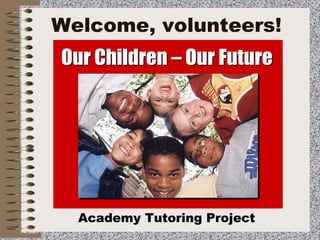
Introduction to volunteering academy tutoring project ocof power point presentation
- 1. Welcome, volunteers! Our Children – Our Future Academy Tutoring Project
- 2. Our Purpose: • Improve student achievement • Build student confidence and pride in accomplishment • Improve student’s attitude toward school • Provide a positive role model • Broaden the experience of tutor & student
- 3. Team of Support Principal Teacher Site Coordinator Tutor Program Staff Reading & Math Specialists
- 4. Who are our students? • Children “on the brink of success” • Living in poverty or single-parent homes • Caregivers with limited education • Limited exposure to people or experiences outside the neighborhood
- 5. Building trust is important • Be reliable. • Be sincere. • Expect the best. • Don’t be judgmental. • Don’t be easily offended.
- 6. Getting to Know Your Student 1. Learn the student’s name. 2. Make sure the student knows your name. 3. Go over student orientation checklist. 4. Talk about interests, but don’t get too personal.
- 7. Setting Expectations • Establish expectations at the beginning of the tutoring relationship • Ask for – Respect – Participation – Effort and Integrity At the end of each session, ask the student to grade the experience. Was it boring? Exciting? Productive?
- 8. Getting the most out of your tutoring session • Each school is different. • Establish a routine for meeting your student. • Tutor in designated areas • Limit distractions. • Clear the desk. • Sit next to your student. • Break tasks into manageable pieces.
- 9. Individual Learning Styles • “Learning Style” is the way a person takes in, stores, and retrieves information • Three main types of learners Auditory: learns by listening and discussing Visual: learns by visualizing and looking at text, charts, and pictures Tactile: learns by doing and being physically involved in a task
- 10. Putting Learning Styles to Work • The more sensory pathways students use, the more likely they will retain the information. • Once you’ve identified your student’s learning style preference, try to use that technique as often as possible in your sessions.
- 11. Making Connections Students reinforce learning by making connections to other experiences: • Text to Text-relate to another story • Text to World-relate to something they’ve seen or heard about • Text to Self-relate to events in their own lives • Math students can connect problems to things they know (money, objects, scores)
- 12. Coaching Techniques • Converse with your student. • Encourage your student to try. • Practice active listening. • Vary format and pace of session. • Feel free to be creative. Make it fun.
- 13. Correcting Mistakes • It’s OK to make mistakes. • Help the child self-correct mistakes. • Prompt child without giving the answer. Things to say: Try again, Did that make sense? What else could it be? What if you…? • Give continuous reinforcement. • Be encouraging. Let student throw out ideas freely.
- 14. Offering Encouragement, Support, and Praise • SMILE! • Listen with interest. • Be honest. Praise the effort, even if the result falls short.
- 15. Closing the Tutoring Session • Summarize successes. • Let student know what you will report to the teacher. • Let student know when you will return. • End on a positive note.
- 16. Elementary Tutoring Schedule Mon Tues Wed Thur Fri Tutor Tutor 1 2 Tutor Tutor 1 2 Tutor Tutor 1 2 Tutor Tutor 1 2
- 17. Some “Dos …” o DO take your volunteer commitment seriously. o DO maintain confidentiality regarding student information. o DO follow all school regulations. o DO use tutoring time appropriately. o Do tutor only in areas designated by the school. Rooms must be located in highly trafficked areas visible to faculty and staff at all times. o DO wear volunteer badge at all times. o DO maintain a neat and appropriate appearance. o DO call the school site coordinator if you can’t keep your scheduled tutoring session. o DO notify the program manager if you choose to leave your tutoring position.
- 18. “…and Don’ts” o DON’T meet or take children off school grounds for any reason. o DON’T contact students outside the tutoring session (no phone calls, emails, or visits off campus). o DON’T question children about personal issues; however, contact school officials if you suspect your student might be in an unsafe environment. o DON’T bring food or gifts to students. o DON’T provide religious materials or seek to impose religious views on the student. o DON’T discipline students. Refer behavior problems to the site coordinator.
- 19. and remember… • Tutoring isn’t a “quick fix.” Don’t expect instant success or major improvement right away. • Older students might display “attitude” as a coping mechanism. • Each school is different. Be patient with school staff and facilities. • What you are doing is very important!
- 20. Volunteer Procedures And Forms
- 21. Tutor Agreement Please take your commitment seriously. If at any time you find you can no longer keep the terms of this agreement, contact the Program Manager.
- 23. Keeping in Touch •Review School Calendar •Keep phone number and email address of school coordinator and front office staff with you. •Exchange email address with teacher. •Check email for updates. •“Friend” Facebook page • Check text messages for updates as well.
- 24. What’s Next? • Complete fingerprinted background check • Tutoring assignment • Confirmation letter with maps and information sheet-or email • Meet your student